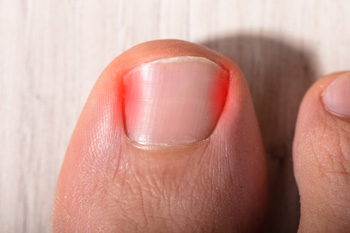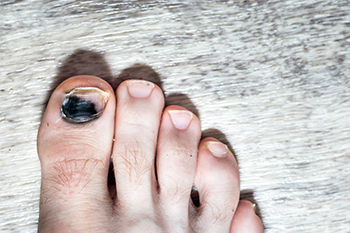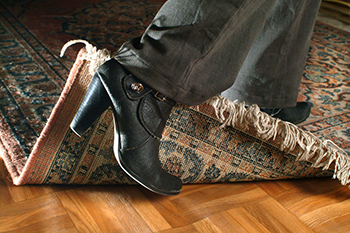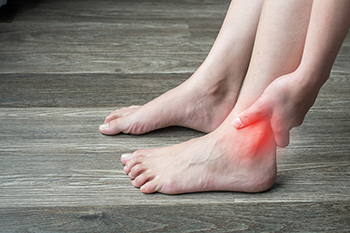Dallas Metro / North Texas
(214) 710-1028
July 2022
Ingrown Toenail Surgery Pain

Ingrown toenails are a common yet uncomfortable and potentially painful foot condition. This unsightly condition occurs when the side of a toenail essentially grows into the skin. If the toenail is cut too short or if it has a natural curved shape, the nail may be especially prone to growing into the skin. This condition is most common in the big toe. There are a variety of home remedies to treat ingrown toenails. However, if these remedies do not work or if you have multiple ingrown toenails, your podiatrist may recommend undergoing a surgical procedure. This procedure might include removing part of the nail or the entire affected nail. Many patients are curious to know whether or not this procedure is painful. Although each patient’s experience is unique, there is information about this procedure that may be applicable to you. For example, before the surgical procedure, you may need an anesthetic injection that can potentially be uncomfortable for some patients. However, many patients report that the actual procedure following the injection is quite painless. After the procedure, you might experience pain when the numbness slowly abates. To treat this pain following the procedure, you might be able to use over-the-counter medications. If you are curious about the pain you could feel during a surgical procedure to remove an ingrown toenail, speak to your podiatrist.
Ingrown toenails can become painful if they are not treated properly. For more information about ingrown toenails, contact Kellvan Cheng, DPM of Elite Foot & Ankle. Our doctor can provide the care you need to keep you pain-free and on your feet.
Ingrown Toenails
Ingrown toenails occur when a toenail grows sideways into the bed of the nail, causing pain, swelling, and possibly infection.
Causes
- Bacterial infections
- Improper nail cutting such as cutting it too short or not straight across
- Trauma to the toe, such as stubbing, which causes the nail to grow back irregularly
- Ill-fitting shoes that bunch the toes too close together
- Genetic predisposition
Prevention
Because ingrown toenails are not something found outside of shoe-wearing cultures, going barefoot as often as possible will decrease the likeliness of developing ingrown toenails. Wearing proper fitting shoes and using proper cutting techniques will also help decrease your risk of developing ingrown toenails.
Treatment
Ingrown toenails are a very treatable foot condition. In minor cases, soaking the affected area in salt or antibacterial soaps will not only help with the ingrown nail itself, but also help prevent any infections from occurring. In more severe cases, surgery is an option. In either case, speaking to your podiatrist about this condition will help you get a better understanding of specific treatment options that are right for you.
If you have any questions please feel free to contact our office located in Carrollton, TX . We offer the newest diagnostic and treatment technologies for all your foot and ankle needs.
When Toenails Turn Black

A blackened area under the toenail occurs when blood collects beneath the nail as the result of damage to the toe. The condition is sometimes referred to as tennis toe, or runner’s toe. It is also known as a subungual hematoma. When the toe is repeatedly jammed against the toebox of a shoe, it may cause bruising that seems to turn the toenail black. The big toe is typically affected, causing a throbbing pain under the nail. The condition is often the result of constant changes in direction. This can occur while playing certain sports or experiencing a continuous pounding while running. It can also be caused by a traumatic injury to the toe, such as dropping something heavy on the toe. In many cases, the toe will heal on its own with rest, ice, and elevation. But if the toe is causing intense pain or the area becomes infected, it is a good idea to see a podiatrist for a complete exam and proper diagnosis. In some cases, the area may need to be drained or the toenail itself removed by a podiatrist.
Toe pain can disrupt your daily activities. If you have any concerns, contact Kellvan Cheng, DPM of Elite Foot & Ankle. Our doctor can provide the care you need to keep you pain-free and on your feet.
What Causes Toe Pain?
Most severe toe pain is caused due to a sports injury, trauma from dropping something heavy on the toe, or bumping into something rigid. Other problems can develop over time for various reasons.
Toe pain can be caused by one or more ailments. The most common include:
- Trauma
- Sports injury
- Wearing shoes that are too tight
- Arthritis
- Gout
- Corns and calluses
- Hammertoe
- Bunions
- Blisters
- Ingrown toenails
- Sprains
- Fractures (broken bones)
- Dislocations
When to See a Podiatrist
- Severe pain
- Persistent pain that lasts more than a week
- Signs of infection
- Continued swelling
- Pain that prevents walking
Diagnosis
In many cases the cause of toe pain is obvious, but in others, a podiatrist may want to use more advanced methods to determine the problem. These can range from simple visual inspections and sensation tests to X-rays and MRI scans. Prior medical history, family medical history, and any recent physical traumatic events will all be taken into consideration for a proper diagnosis.
Treatment
Treatments for toe pain and injuries vary and may include shoe inserts, padding, taping, medicines, injections, and in some cases, surgery. If you believe that you have broken a toe, please see a podiatrist as soon as possible.
If you have any questions please feel free to contact our office located in Carrollton, TX . We offer the newest diagnostic tools and technology to treat your foot and ankle needs.
Ways Seniors Can Prevent Falls at Home

The risk of falling at home increases after reaching the age of 65. This can be caused by diminished balance, strength, and eyesight. Other causes may be dizzying effects from certain medications and neuropathy problems that affect the feet. Further, if you fall once, you are far more likely to fall again, unless changes are made around the house. The majority of home falls take place in the bathroom, experts say. Some preventative measures include installing grab bars in the bath and shower area, putting a chair in the bathing area, and adding non-slip strips or a mat on the tub floor. Other parts of the home can also be modified to decrease the likelihood of a fall. Remove throw rugs, declutter passageways, and add lighting in darker areas, especially stairs and long hallways. Keep a clear path to the bathroom to increase your safety at night. Make sure you use handrails or a walking device if dizziness or balance issues are a problem. Wear shoes with non-skid soles, and avoid going barefoot. If you need more information on preventing falls, please contact a podiatrist who can offer suggestions to help keep you upright.
Preventing falls among the elderly is very important. If you are older and have fallen or fear that you are prone to falling, consult with Kellvan Cheng, DPM from Elite Foot & Ankle. Our doctor will assess your condition and provide you with quality advice and care.
Every 11 seconds, an elderly American is being treated in an emergency room for a fall related injury. Falls are the leading cause of head and hip injuries for those 65 and older. Due to decreases in strength, balance, senses, and lack of awareness, elderly persons are very susceptible to falling. Thankfully, there are a number of things older persons can do to prevent falls.
How to Prevent Falls
Some effective methods that older persons can do to prevent falls include:
- Enrolling in strength and balance exercise program to increase balance and strength
- Periodically having your sight and hearing checked
- Discuss any medications you have with a doctor to see if it increases the risk of falling
- Clearing the house of falling hazards and installing devices like grab bars and railings
- Utilizing a walker or cane
- Wearing shoes that provide good support and cushioning
- Talking to family members about falling and increasing awareness
Falling can be a traumatic and embarrassing experience for elderly persons; this can make them less willing to leave the house, and less willing to talk to someone about their fears of falling. Doing such things, however, will increase the likelihood of tripping or losing one’s balance. Knowing the causes of falling and how to prevent them is the best way to mitigate the risk of serious injury.
If you have any questions, please feel free to contact our office located in Carrollton, TX . We offer the newest diagnostic and treatment technologies for all your foot care needs.
Heel Pain in the Morning?
Know the Warning Signs of Tarsal Tunnel Syndrome

The tibial nerve is an offshoot of the sciatic nerve at the back of the leg which travels down the leg and eventually passes through a narrow structure in the ankle (the tarsal tunnel). When there is an obstruction within or outside the tunnel that causes the tibial nerve to become pressurized or compressed, this is known as tarsal tunnel syndrome. The symptoms of tarsal tunnel syndrome may occur anywhere along the path of the tibial nerve, including the inside of the ankle and on the bottom of the foot. Symptoms may include tingling or numbness, shooting, sharp pains, burning, pins-and-needles sensations, or electric shocks. Any number of factors may cause the tibial nerve to become pinched, from benign growths within or outside the tarsal tunnel, inflammation from injuries or arthritis, diabetes, flat feet, and more. A podiatrist may treat tarsal tunnel syndrome with anti-inflammatory medications, steroid injections, custom shoes, orthotics, or even surgery in severe cases. It is important to seek treatment from a podiatrist for tarsal tunnel syndrome as failure to repair the nerve may result in permanent nerve damage.
Tarsal tunnel syndrome can be very uncomfortable to live with. If you are experiencing tarsal tunnel syndrome, contact Kellvan Cheng, DPM of Elite Foot & Ankle. Our doctor can provide the care you need to keep you pain-free and on your feet.
Tarsal Tunnel Syndrome
Tarsal tunnel syndrome, which can also be called tibial nerve dysfunction, is an uncommon condition of misfiring peripheral nerves in the foot. The tibial nerve is the peripheral nerve in the leg responsible for sensation and movement of the foot and calf muscles. In tarsal tunnel syndrome, the tibial nerve is damaged, causing problems with movement and feeling in the foot of the affected leg.
Common Cause of Tarsal Tunnel Syndrome
- Involves pressure or an injury, direct pressure on the tibial nerve for an extended period of time, sometimes caused by other body structures close by or near the knee.
- Diseases that damage nerves, including diabetes, may cause tarsal tunnel syndrome.
- At times, tarsal tunnel syndrome can appear without an obvious cause in some cases.
The Effects of Tarsal Tunnel Syndrome
- Different sensations, an afflicted person may experience pain, tingling, burning or other unusual sensations in the foot of the affected leg.
- The foot muscles, toes and ankle become weaker, and curling your toes or flexing your foot can become difficult.
- If condition worsens, infections and ulcers may develop on the foot that is experiencing the syndrome.
A physical exam of the leg can help identify the presence of tarsal tunnel syndrome. Medical tests, such as a nerve biopsy, are also used to diagnose the condition. Patients may receive physical therapy and prescriptive medication. In extreme cases, some may require surgery.
If you have any questions please feel free to contact our office located in Carrollton, TX . We offer the newest diagnostic and treatment technologies for all your foot and ankle needs.
Blog Archives
- July 2025
- June 2025
- May 2025
- April 2025
- March 2025
- February 2025
- January 2025
- December 2024
- November 2024
- October 2024
- September 2024
- August 2024
- July 2024
- June 2024
- May 2024
- April 2024
- March 2024
- February 2024
- January 2024
- December 2023
- November 2023
- October 2023
- September 2023
- August 2023
- July 2023
- June 2023
- May 2023
- April 2023
- March 2023
- February 2023
- January 2023
- December 2022
- November 2022
- October 2022
- September 2022
- August 2022
- July 2022
- June 2022
- May 2022
- April 2022
- March 2022
- February 2022
- January 2022
- December 2021
- November 2021
- October 2021
- September 2021
- August 2021
- July 2021
- June 2021
- May 2021
- April 2021
- March 2021
- April 2020
- March 2020
- February 2020
- January 2020
- December 2019
- November 2019
- October 2019
- September 2019
- August 2019
- July 2019
- June 2019
- May 2019
- April 2019
- March 2019
- February 2019
- January 2019
- December 2018
- November 2018
- October 2018
- September 2018
- August 2018
- July 2018
- June 2018
- May 2018
- April 2018
- March 2018
- February 2018
- January 2018
- December 2017
- November 2017
- October 2017





